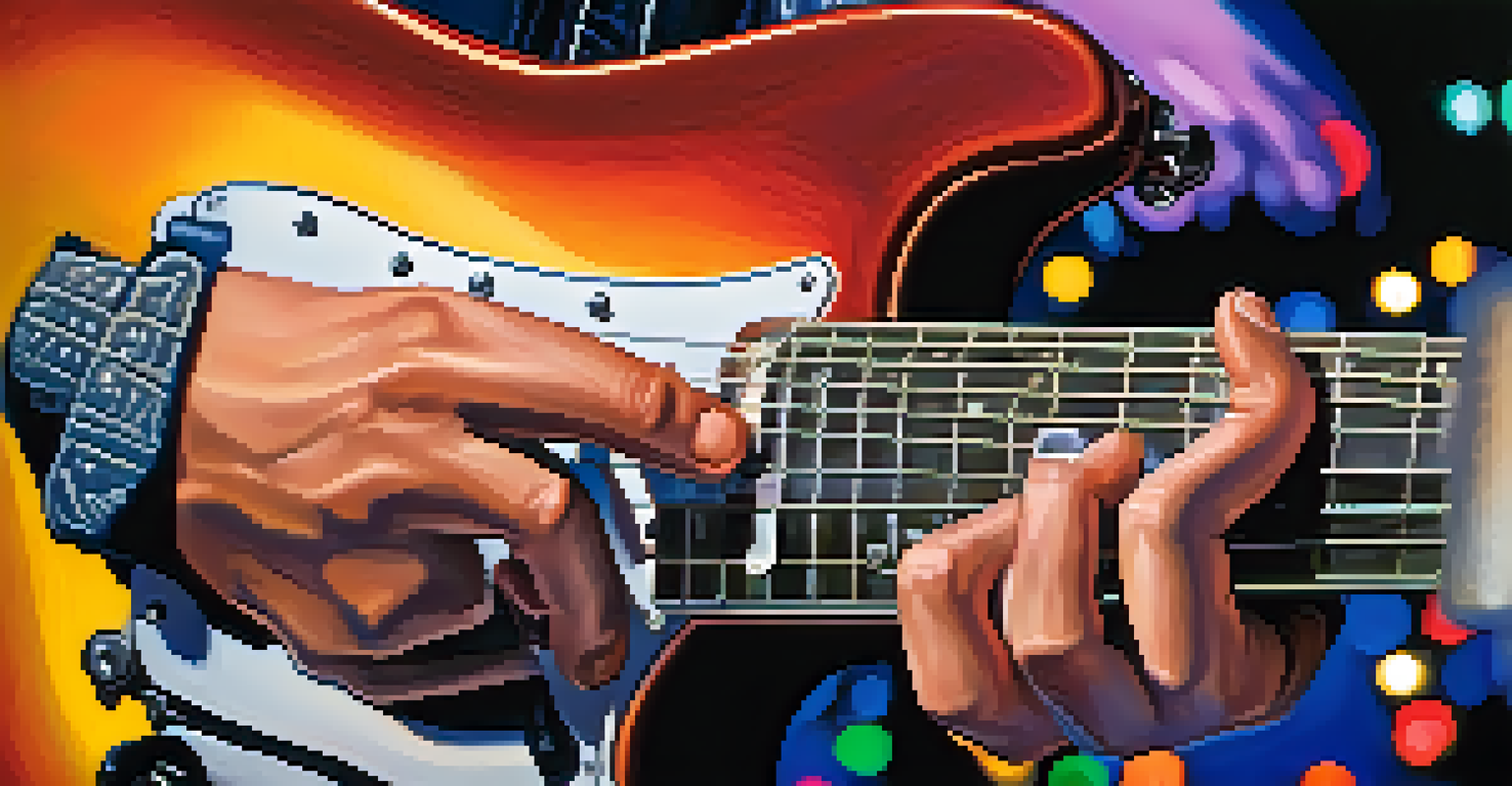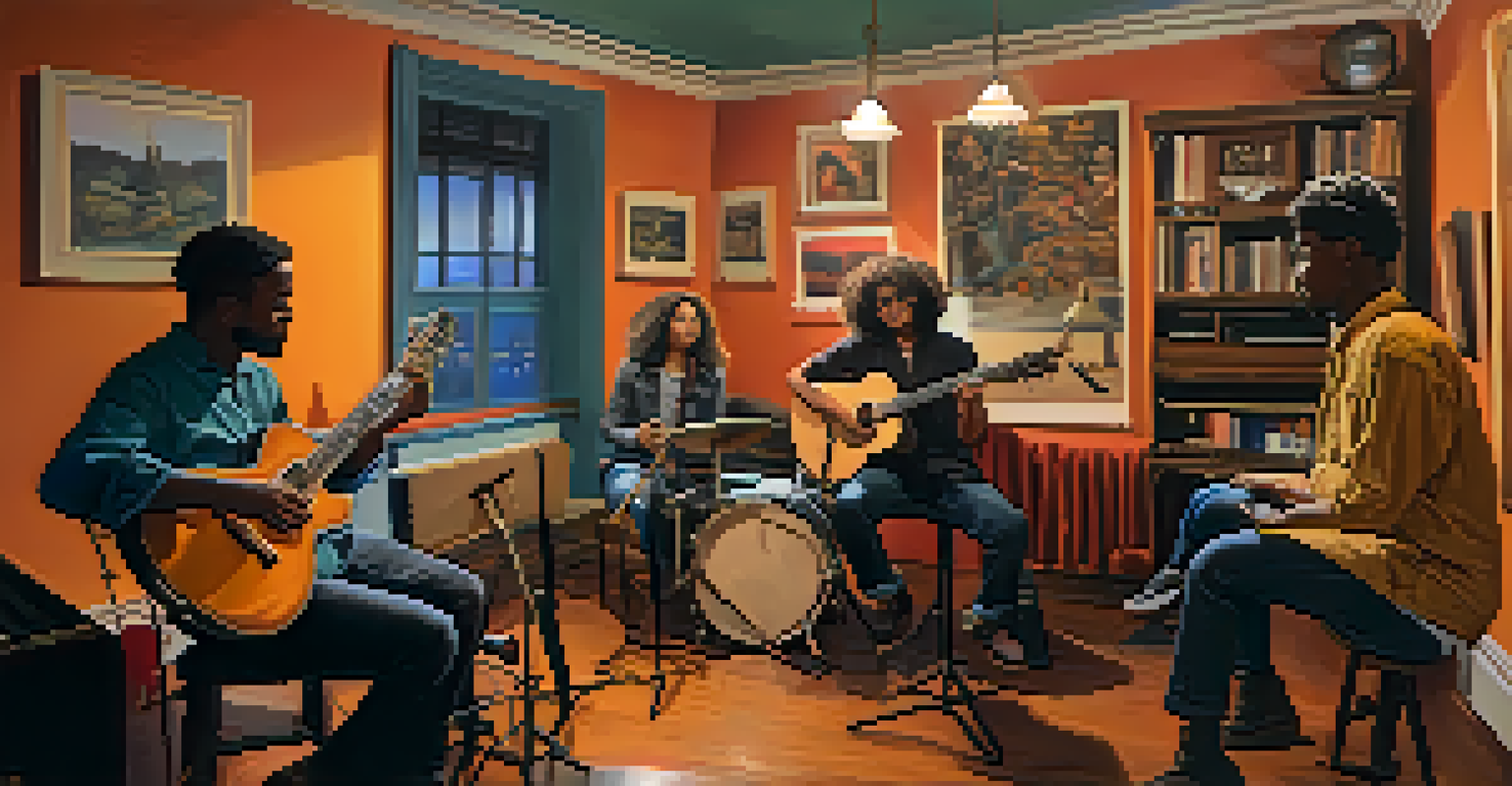Common Mistakes in Rhythm Guitar Playing and How to Fix Them

Neglecting the Importance of Timing and Rhythm
One of the most common mistakes in rhythm guitar playing is underestimating the role of timing. Many players focus solely on chord changes and melodies, but if your timing is off, it can throw everything else out of sync. Good timing is like the backbone of a song, providing the structure that supports other elements.
Music is the shorthand of emotion.
Practicing with a metronome can significantly enhance your timing skills. Start slow, and gradually increase the tempo as you become more comfortable. This approach helps you internalize the beat, making it second nature over time.
Additionally, try playing along with your favorite songs to see how your timing stacks up. Pay attention to how each instrument interacts with the beat. By doing this, you'll develop a better sense of rhythm and how to keep the groove flowing.
Overcomplicating Strumming Patterns
Another mistake many rhythm guitarists make is overcomplicating their strumming patterns. While it might be tempting to showcase your skills with intricate patterns, simplicity often yields better results in a band setting. A clear and consistent strumming pattern can enhance the overall sound without drawing attention away from the melody.

To fix this, start with basic downstrokes and gradually incorporate upstrokes. Focus on keeping a steady pulse, and once you're comfortable, you can experiment with embellishments without losing the core rhythm. Simple patterns can still be dynamic and engaging.
Master Timing for Better Rhythm
Good timing is essential for rhythm guitar playing, as it serves as the backbone that supports all other musical elements.
Moreover, consider the genre you’re playing. Different styles have characteristic strumming patterns, so spend some time mastering a few essential ones for each genre. This will allow you to adapt your playing to fit the music better.
Ignoring Dynamics and Volume Control
A common pitfall in rhythm guitar playing is neglecting dynamics, which refers to the variations in volume and intensity. Playing at a constant volume can make your music sound flat and lifeless. Dynamics add emotion and texture to your performance, making it more engaging for listeners.
The most important thing is to enjoy your life—to be happy—it’s all that matters.
To improve your dynamics, practice varying your strumming force. Try playing the same chord progression softly and then loudly to see how it changes the feel of the music. This exercise helps you discover the impact of volume on the overall sound.
Additionally, pay attention to how other instruments in your band are playing. Adjust your dynamics accordingly to complement their sounds. By being aware of your volume in relation to others, you can create a more cohesive performance.
Failing to Listen and Adapt to Other Musicians
One of the biggest mistakes rhythm guitarists can make is playing without listening to the other musicians. It’s easy to get caught up in your own part, but music is collaborative, and being aware of what others are doing is crucial. Listening helps you find the right spots to emphasize or pull back, enhancing the overall blend.
To address this, practice playing with other musicians regularly. This could be in a jam session or a band rehearsal. By actively listening and adapting to their playing styles, you’ll develop a better sense of musical interaction, which is vital for rhythm guitarists.
Simplicity in Strumming Patterns
Keeping strumming patterns simple often results in a more engaging sound, allowing the melody to shine without distraction.
Also, consider recording your practice sessions. Listening back can reveal how well you’re locking in with the other instruments. This self-assessment allows you to identify areas for improvement and encourages a more collaborative mindset.
Neglecting Proper Finger Placement and Technique
Improper finger placement and technique can lead to a range of issues, including muted strings and poor tone. Many players rush through their chord changes without ensuring their fingers are positioned correctly. This oversight can hinder the overall quality of your sound and complicate transitions.
To improve your finger placement, start by practicing each chord slowly, ensuring that each note rings out clearly. Pay attention to the position of your fingers and make adjustments as necessary. Over time, this will lead to more fluid transitions and a cleaner sound.
Incorporating finger exercises into your practice routine can also help enhance your technique. These exercises build strength and dexterity, which are essential for achieving the precision needed in rhythm guitar playing.
Failing to Practice Regularly and Consistently
One of the most prevalent mistakes among rhythm guitarists is not practicing enough. While it might seem obvious, consistent practice is the key to mastery. Without regular practice, even the most talented musicians can plateau and lose their edge.
To create a productive practice routine, set specific goals for each session. Whether it’s mastering a new chord progression or refining your strumming patterns, having clear objectives will keep you focused and motivated. Consistency is what transforms practice into progress.
Listen and Adapt to Others
Collaborative music-making requires actively listening to fellow musicians to enhance the overall blend and interaction in your performance.
Additionally, consider incorporating short, frequent practice sessions into your routine rather than longer, infrequent ones. This approach can help keep your skills sharp and allows for more focused, effective learning.
Not Experimenting with Different Styles and Techniques
Many rhythm guitarists stick to familiar styles and techniques, limiting their growth as musicians. While it's essential to master your preferred genre, exploring different styles can open up new avenues for creativity and expression. It can also enhance your versatility as a player.
Try experimenting with genres outside your comfort zone, whether it’s funk, jazz, or country. Each style has unique techniques and rhythms that can enrich your playing. For example, incorporating palm muting from rock or syncopation from funk can add depth to your rhythm.

Moreover, don’t shy away from learning new techniques, such as fingerpicking or hybrid picking. These methods can provide fresh textures and dynamics to your playing. The more you experiment, the more you'll find your unique voice as a rhythm guitarist.